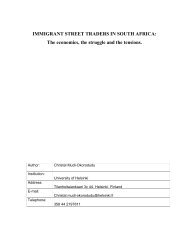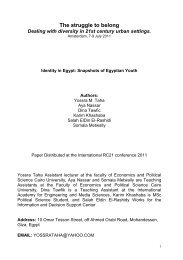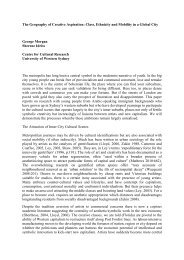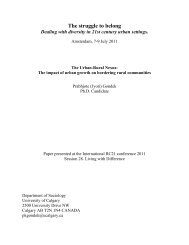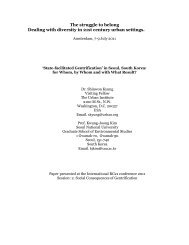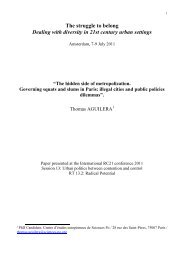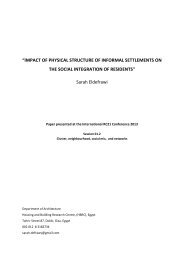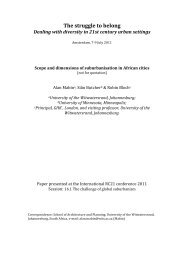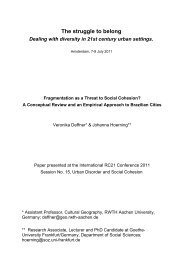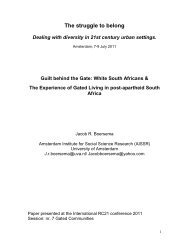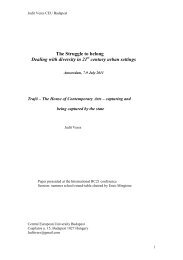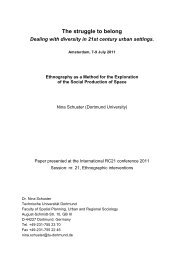Gentrification in the mill land areas of Mumbai city - RC21 ORG ...
Gentrification in the mill land areas of Mumbai city - RC21 ORG ...
Gentrification in the mill land areas of Mumbai city - RC21 ORG ...
Create successful ePaper yourself
Turn your PDF publications into a flip-book with our unique Google optimized e-Paper software.
edevelopment process to <strong>the</strong> usage <strong>of</strong> <strong>city</strong> space for various <strong>in</strong>terests a parallel set <strong>of</strong><br />
<strong>in</strong>formal rules engage and <strong>in</strong>fluence <strong>the</strong> activities.<br />
Conclusion<br />
The process <strong>of</strong> gentrification <strong>in</strong> <strong>the</strong> <strong>city</strong> is very unique <strong>in</strong> nature. On one side <strong>the</strong> <strong>mill</strong> <strong>land</strong>s<br />
are go<strong>in</strong>g for sale one after <strong>the</strong> o<strong>the</strong>r as it is <strong>in</strong> loss and <strong>the</strong>re is a lack <strong>of</strong> <strong>in</strong>terest <strong>of</strong> <strong>the</strong><br />
owners. Therefore <strong>the</strong>y started us<strong>in</strong>g <strong>the</strong> <strong>land</strong> for various o<strong>the</strong>r purposes which can generate<br />
much more pr<strong>of</strong>it. On <strong>the</strong> o<strong>the</strong>r side <strong>the</strong> workers are also <strong>in</strong>volved <strong>in</strong> <strong>the</strong> nexus <strong>of</strong><br />
redevelopment <strong>of</strong> <strong>the</strong>ir chawls along with <strong>the</strong> builders. Los<strong>in</strong>g <strong>the</strong>ir jobs for years, <strong>the</strong> money<br />
<strong>the</strong>y received as VRS (Voluntary Retirement Scheme) had been allocated for different<br />
purposes. Those workers who have not received any amount through VRS are <strong>in</strong> poverty. But<br />
many <strong>of</strong> <strong>the</strong> <strong>mill</strong> workers are <strong>in</strong>terested <strong>in</strong> <strong>the</strong> developmental project because only through<br />
this <strong>the</strong>y are acquir<strong>in</strong>g an opportunity to ga<strong>in</strong> some assets. On <strong>the</strong> one hand <strong>the</strong>y are liv<strong>in</strong>g <strong>in</strong><br />
a chawl <strong>in</strong> a prime locality at a very nom<strong>in</strong>al rent. When <strong>the</strong>ir houses are go<strong>in</strong>g for<br />
redevelopment ei<strong>the</strong>r <strong>the</strong>y are receiv<strong>in</strong>g a flat <strong>in</strong> <strong>the</strong> tower build<strong>in</strong>g or huge compensation<br />
from <strong>the</strong> builders <strong>in</strong> order to vacate <strong>the</strong> chawl. In many cases s<strong>in</strong>ce current rent <strong>of</strong> <strong>the</strong> area is<br />
very high <strong>the</strong> room owners <strong>of</strong>ten give <strong>the</strong>ir room/flat <strong>in</strong> rent and move to suburban <strong>areas</strong> <strong>in</strong><br />
search <strong>of</strong> a larger space. As <strong>the</strong> family expands <strong>the</strong>y require a larger space to live and <strong>the</strong><br />
suburbs become <strong>the</strong> important location. But <strong>the</strong>re are also certa<strong>in</strong> families who get entrapped<br />
<strong>in</strong> this process. Nei<strong>the</strong>r <strong>the</strong>y go for <strong>the</strong> redevelopment <strong>of</strong> <strong>the</strong>ir chawls due to <strong>the</strong> high<br />
ma<strong>in</strong>tenance charge nor could <strong>the</strong>y live <strong>in</strong> such dilapidated condition. Individuals and<br />
different social groups are associated with <strong>the</strong> flow or movement <strong>in</strong> a very dist<strong>in</strong>ct manner. It<br />
is not only <strong>the</strong> differential rate <strong>of</strong> mobility <strong>of</strong> <strong>the</strong> <strong>in</strong>dividual or groups that determ<strong>in</strong>es <strong>the</strong><br />
flow but <strong>the</strong> power determ<strong>in</strong>es <strong>the</strong> mobility or <strong>the</strong> control over mobility. It is always that<br />
somebody triggers <strong>the</strong> flow and o<strong>the</strong>rs rema<strong>in</strong> at <strong>the</strong> receiv<strong>in</strong>g end. It is not <strong>the</strong> unequal<br />
distribution that some people move more than o<strong>the</strong>rs and that some have more control than<br />
o<strong>the</strong>rs. It is that <strong>the</strong> mobility and control <strong>of</strong> some groups can actively weaken o<strong>the</strong>r people.<br />
The “power geometry <strong>of</strong> time space compression” <strong>of</strong> some groups can underm<strong>in</strong>e <strong>the</strong> power<br />
<strong>of</strong> o<strong>the</strong>rs (Massey, 1991:2; Guha Banerjee, 2010:199). At this juncture <strong>the</strong> urban built up area<br />
become a space <strong>of</strong> contradiction and contestation. These aggravated when <strong>the</strong> <strong>mill</strong> workers<br />
started demand<strong>in</strong>g <strong>the</strong>ir houses <strong>in</strong> <strong>the</strong> <strong>mill</strong> <strong>land</strong>s as per <strong>the</strong> DC Rules which states that one<br />
third <strong>of</strong> <strong>the</strong> <strong>mill</strong> <strong>land</strong> will be used for <strong>the</strong> hous<strong>in</strong>g purpose <strong>of</strong> <strong>the</strong> <strong>mill</strong> workers. Eighteen <strong>mill</strong>s<br />
have submitted <strong>the</strong>ir <strong>land</strong> till date and numbers <strong>of</strong> <strong>mill</strong> owners are <strong>in</strong> <strong>the</strong> process <strong>of</strong><br />
submitt<strong>in</strong>g <strong>the</strong> one third <strong>of</strong> <strong>land</strong>. Presently 6,948 houses has been built by MHADA, <strong>the</strong>refore



